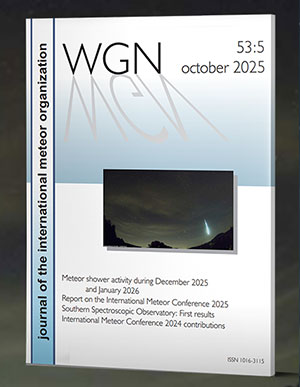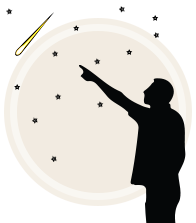During this period the moon reaches its full
phase on Tuesday December 21st. At this time the moon lies opposite the sun and
is above the horizon all night long from most locations. This is the worst time
to attempt to view meteor activity as the bright moonlight will obscure all but
the brightest meteors. The estimated total hourly rates for evening observers
this week is near three from the northern hemisphere and two for observers south
of the equator. For morning observers the estimated total hourly rates should be
near ten from the northern hemisphere and nine as seen from the southern hemisphere.
The actual rates will also depend on factors such as personal light and motion
perception, local weather conditions, alertness and experience in watching meteor
activity. Rates are reduced during this period due to moonlight.
The radiant (the area of the sky where meteors appear
to shoot from) positions and rates listed below are exact for Saturday night/Sunday
morning December 18/19. These positions do not change greatly day to day so the listed
coordinates may be used during this entire period. Most star atlases (available at
science stores and planetariums) will provide maps with grid lines of the celestial
coordinates so that you may find out exactly where these positions are located in
the sky. A planisphere or computer planetarium program is also useful in showing
the sky at any time of night on any date of the year. Activity from each radiant
is best seen when it is positioned highest in the sky, either due north or south
along the meridian, depending on your latitude. It must be remembered that meteor
activity is rarely seen at the radiant position. Rather they shoot outwards from
the radiant so it is best to center your field of view so that the radiant lies
at the edge and not the center. Viewing there will allow you to easily trace the
path of each meteor back to the radiant (if it is a shower member) or in another
direction if it is a sporadic. Meteor activity is not seen from radiants that are
located below the horizon. The positions below are listed in a west to east
manner in order of right ascension (celestial longitude). The positions listed
first are located further west therefore are accessible earlier in the night while
those listed further down the list rise later in the night.
The following showers are expected to be active this week. The detailed descriptions
will be continued next week when the moonlight is not as intense.
| SHOWER | DATE OF MAXIMUM ACTIVITY | CELESTIAL POSITION | ENTRY VELOCITY | CULMINATION | HOURLY RATE | CLASS* | RA (RA in Deg.) DEC | Km/Sec | Local Standard Time | North-South | Antihelions (ANT) | – | 06:40 (100) +23 | 30 | 00:00 | 2 – 2 | II | Monocerotids (MON) | Dec 08 | 07:08 (107) +07 | 41 | 01:00 | <1 - <1 | II | Geminids (GEM) | Dec 14 | 07:56 (119) +31 | 35 | 02:00 | 1 – 1 | I | Sigma Hydrids (HYD) | Dec 08 | 08:56 (134) +00 | 61 | 03:00 | <1 - <1 | II | December Leonis Minorids (DLE) | Dec 20 | 10:44 (161) +31 | 64 | 05:00 | 1 – 1 | II | Coma Berenicids (COM) | Dec 16 | 11:48 (177) +18 | 65 | 06:00 | 1 – 1 | II | Ursids (URS) | Dec 22 | 14:12 (213) +75 | 33 | 08:00 | <1 - <1 | I |



 You saw something bright and fast? Like a huge shooting star? Report it: it may be a fireball.
You saw something bright and fast? Like a huge shooting star? Report it: it may be a fireball.  You counted meteors last night? Share your results with us!
You counted meteors last night? Share your results with us!  You took a photo of a meteor or fireball? You have a screenshot of your cam? Share it with us!
You took a photo of a meteor or fireball? You have a screenshot of your cam? Share it with us!  You caught a meteor or fireball on video? Share your video with us!
You caught a meteor or fireball on video? Share your video with us!